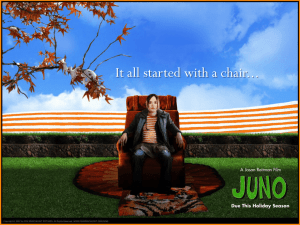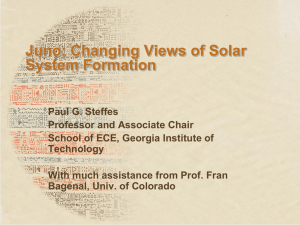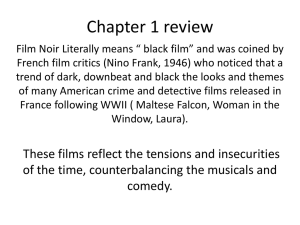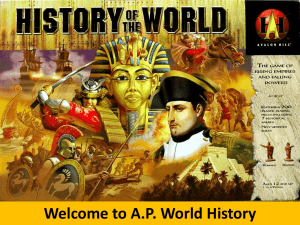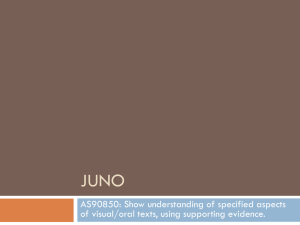Themes in Juno
advertisement
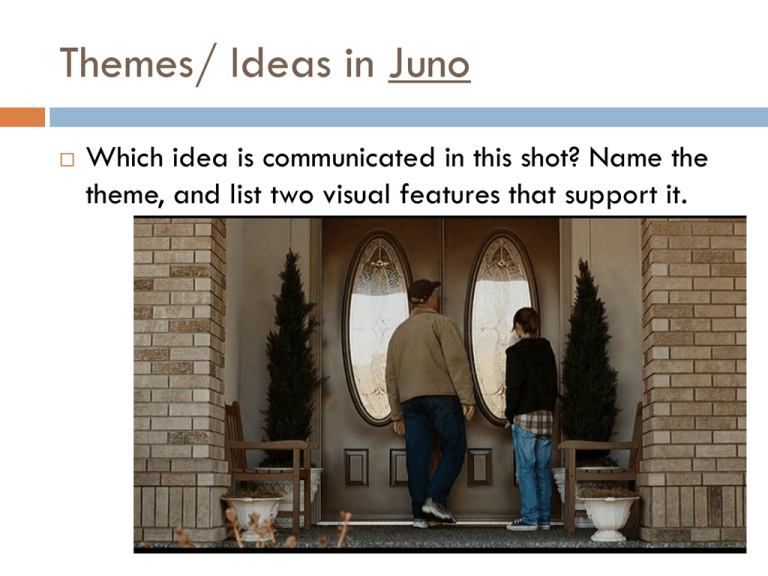
Themes/ Ideas in Juno Which idea is communicated in this shot? Name the theme, and list two visual features that support it. Themes/ Ideas in Juno WALT: Describe important ideas in the film. Explain how visual/ oral features are used to support ideas. Themes/ Ideas in Juno 1. 2. 3. In groups of three, discuss the important ideas in Juno. Use the screenshots on the projector for ideas. Your group will need to describe one important idea to the class. Themes/ Ideas in Juno Themes/ Ideas in Juno 1. 2. 3. 4. Collect a screenshot from the front. In groups of two or three, analyse the shot – explain the idea, and the techniques in the shot that support it. Link to other scenes – where else in the film is this idea important? Present your analysis to the class. Themes/ Ideas in Juno Next Week: Themes/ideas in Juno. Music in Juno Returning and analysing essays. Themes/Ideas in Juno Is Juno a typical teenager? List her characteristics and actions that are typical and unusual: Typical Unusual WALT: Explain how important ideas are communicated in the text. Scene Analysis: The Mall Use the headings below to record information about the scene. Visual/oral features: (camera shots/angles, lighting, costume, dialogue) Important because: (what do we learn about characters and themes in this scene?) Links to other scenes: (how does this scene develop the narrative?) Scene Analysis: The Mall Visual/oral features: HA tracking shot of Vanessa – makes the audience feel like they are Juno and Leah, ‘spying’ on Vanessa. Dialogue Vanessa: “I was just shopping, with my girlfriends…” – Juno and Leah are also just hanging out at the mall – similarities? HA CU of Vanessa – shows the joy on Vanessa’s face when she feels the baby kick. Angle shows Juno has the power (to fulfil Vanessa’s dream of motherhood) Scene Analysis: The Mall Important because: Juno and Leah are doing what typical teenage girls would do – hanging out at the mall. Vanessa and her friends are also doing what a group of women might do – shopping together. This shows the differences between childhood and adulthood, and also the similarities. Shows how Juno exists between the two. Scene Analysis: The Mall Links to other scenes: This scene is where Juno realises Vanessa will be a good mother – before she knows that Mark is leaving her. We can assume that, when Juno is on the freeway thinking about what to do (crisis) she thinks back to this scene. Themes/Ideas in Juno: Choice We have examined how choice is expressed in each text we have studied this year. Juno makes difficult and mature choices in the film: Choosing adoption over abortion. Choosing to continue with the adoption, even though her ideal family is compromised. Themes/Ideas in Juno: Choice Visual and oral features are used to show the idea of choice. In the freeway scene, a high angle wide shot is used to show the weight of Juno’s choices. Symbolism: train and road. Themes/Ideas in Juno: Choice Juno chooses adoption over abortion. Dialogue: “Fingernails? Really?” Sound effects: scratching. MS: Juno running away from abortion, showing her choice. Themes/Ideas in Juno: Choice This ECU shows how Juno has chosen to accept compromise – she knows Vanessa will be a good mother, even though her idea of a family is no longer whole. Themes/Ideas in Juno 1. 2. 3. Read through the summary of key themes/ ideas in Juno. For each scene on the reverse of the handout, name the theme it relates to, and describe the visual/oral features that support this theme. Identify the links to other scenes (eg. if you were to write an essay on one of the two themes, which groups of scenes could you use to support your essay?) Essay Analysis This is your English course, your essay, and in the end you are responsible for your achievement. You will self-assess your Juno essay, based on the marking schedule I have given you. I will read your self-assessment and make a comment on how accurate you have been. Activity: Use a different colour to highlight evidence for each line in the marking schedule (six different colours). Essay Analysis Develops some relevant ideas about the text Juno is a character who is strong and independent. She makes her own choices (Achieved) Juno, isolated from the support of her friends and family because of her pregnancy, demonstrates resilience in the way she makes difficult choices and copes with the consequences. For example… (Merit) Essay Analysis Shows some understanding of the writer’s purpose…using particular features …when Juno is parked on the freeway, a high angle shot is used to show the weight of her problems. (Achieved) … shot from a freeway flyover, we look down on Juno in the Previa. The high angle and wide shot combine to make Juno seem small, insignificant, suffering under a great weight. The scene is heavily symbolic – the train tracks are Juno’s ‘out of control’ situation, and the road ahead is Juno’s future. The shot is composed of elements stretching into the distance, showing that Juno has some way to go. (Excellence) Essay Analysis Shows some understanding of an aspect of the text An important event in Juno is the scene where she chooses not to go through with her abortion. This leads on to other events in the film. (Not Achieved) The catalyst in Juno is the scene where Juno cannot go through with her abortion. The challenge of finding and arranging an adoption drives the narrative of the film, and allows Juno’s character to be defined by the choices she makes: choosing to adopt out, choosing a family, and choosing love over perfection in the resolution. (Excellence) Essay Analysis Uses terminology with some accuracy, and key words in the question to structure an answer Have you re-worded the question in your introduction? Have you returned to these key words in each body paragraph? Have you used visual/oral features consistently throughout your essay? Essay Analysis Writes in a mostly structured and focussed manner, with most points addressing the question Do you make three clear points, which address the question? (Achieved) Do your three points link to each other? (Merit) Does each point develop your essay further, forming a convincing argument? (Excellence) Essay Analysis Provides appropriate visual/oral details from the text Do you name a visual/oral feature, and describe an example, for each of your three points? (Achieved) The high angle and wide shot combine to make Juno seem small, insignificant…(Merit) The scene is heavily symbolic – the train tracks are Juno’s ‘out of control’ situation, and the road ahead is Juno’s future… (Merit) Essay Analysis Comment Review your marking schedule. Choose two areas where you have succeeded, and note these as strengths. Choose two areas where improvement is needed, and describe what needs to happen. Themes/Ideas in Juno Next lesson: writing an essay in groups, on the character of Mark. Describe at least one character who played an important role in the text. Explain why the character was important in the text as a whole. Discuss visual/oral text features in your response. Activity: Brainstorm in groups – why is the character of Mark important? Be ready to feed back to the class. Themes/Ideas in Juno Using the template below, briefly describe relationships between Mark, Juno and Vanessa. Mark • Have different goals in life? • • • Share a love of music • • • Juno • J has the baby, V wants a baby • • Vanessa Group Essay Writing 1. 2. 3. 4. 5. Choose a group of three. Collect an information slip – this gives the main point you will make. Choose group roles – a writer, a researcher, and an editor. Record these names on your slip. Construct a body paragraph, loosely following the PEER format. You should aim for 6+ sentences. When you are finished, attach your information slip to your paragraph, and return to Mr Hanson. Introduction Re-word the question Briefly describe the points you will make Write a thesis statement: convince me why Mark is so important to the film. Conclusion Re-word the question Briefly describe the points you have made Re-write your thesis statement: convince me why Mark is so important to the film. Scene by Scene Analysis This is your opportunity to review everything we have learnt so far – and record it in chronological order. On your scene analysis worksheet you should record important details, especially visual/oral features: camera shots/ angles colour lighting costumes / props editing composition music sound effects dialogue narration/ voiceover

